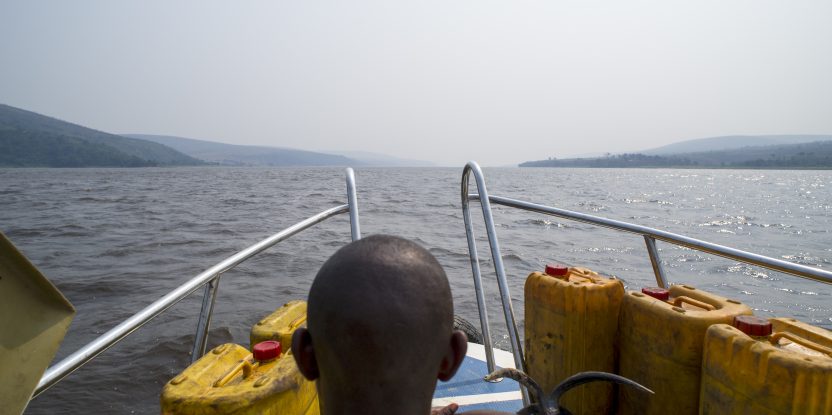
By the time Samuel Muthemba reached the nursery in Yangambi at 5:30 pm, the two boxes of bare-rooted grafted fruit tree seedlings had been in transit for 27 hours. Extracted at 03:00 am the previous day from a cold room at the Center for International Forestry Research and World Agroforestry (CIFOR-ICRAF) in Nairobi, the seedlings had sat on the tarmac in Kinshasa where the “heat could have interfered with their survival”, said the plant technician. They had then been briefly revived by air-conditioning in Sam’s hotel in the capital of the Democratic Republic of Congo. Then they had been transported by air and down the Congo River to reach their final destination: the Yangambi research centre, situated in a UNESCO Biosphere Reserve at the heart of the Congo Basin.
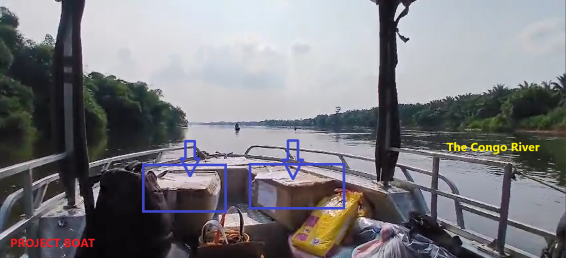
Moving the precious cargo of soil-less seedlings in the prow of a project boat on the Congo River. Photo by Samuel Mutemba/CIFOR-ICRAF
This epic journey was the latest episode in the demanding and ambitious project— Towards food security, better nutrition, and resilience through adaptive learning and nested scale support of agency in local communities in the Yangambi Engagement Landscape or Nutriscapes Yangambi for short. Funded by Good Energies from October 2023 through September 2026, the project goal is “Healthier, better-nourished communities with a greater diversity of nutritious foods and improved on-farm production, which will also minimize pressure on forests.”
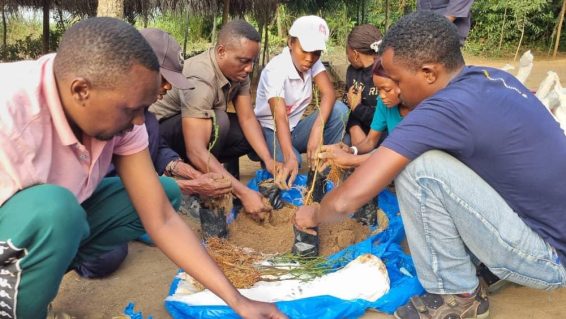
Nursery workers painstakingly unpack the seedlings and start potting them. Photo by Samuel Muthemba / CIFOR-ICRAF
The transfer of these seedlings from Nairobi to Yangambi, a research station in a UNESCO biosphere reserve in the heart of the Congo Basin, constituted an important step towards that ambition. “It was quite a task. It looked impossible,” recalls Muthemba. “But fruit, you know, has a lot of impact. It was like a breakthrough.”
Fruit trees are sorely needed in this landscape, located 100 km from the city of Kisangani, but isolated due to lack of roads. Fruit consumption is very low; the daily diet is pounded cassava with cassava leaves. The local population faces steep health challenges, including a stunting rate of at least 40% in children. Meanwhile the forest, which does hold indigenous fruit tree species, is at risk of disappearing.
The arrival of the seedlings at the research centre marked a crucial step towards addressing these issues. Seven nursery workers were on standby to pot the naked soilless seedlings, which had been meticulously rinsed in water, herbicide and pesticide to prevent transmission of soil-borne pathogens in line with International Plant Protection Convention standards. But it was still touch and go if the seedlings would make it.
As night fell and with only mobile phone lights and the beams of the project car illuminating the scene, the team realized they needed more hands. Maxwell Kubi, senior agroecologist for CIFOR-ICRAF’s FORETS project, called over some nearby football players. Improbably, it worked.
“If not for them, it would have taken longer,” says Muthemba. “We divided them into groups to unpack, re-soil, label, demarcate and water the seedlings. They took the task very seriously. And, once we were done, they burst into victory song .”
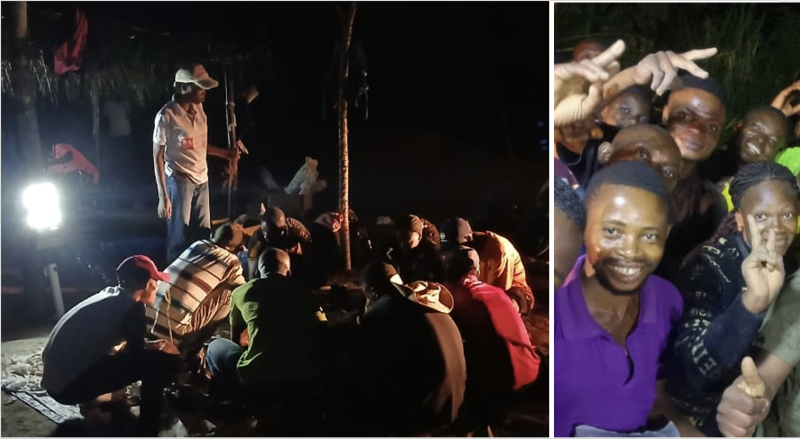
Young people from a football game step make all the difference, later celebrating a job well done. Photos by Samuel Mutenba/CIFOR-ICRAF
Today almost 100% of the 515 seedlings are thriving and are made up of a single variety each of tangerine, lemon, lime and avocado and two varieties each of orange, mandarin, grapefruit and mango.
This epic airlift illustrates the challenges of improving nutrition in remote areas. “The best way is to bring improved exotic and indigenous ‘food’ trees on to farms,” says geneticist and plant breeder Prasad Hendre. “In 3 to 4 years, each of these seedlings will become a tree capable of producing 40-50 scions per season, pieces of stem that can be grafted onto hardy and adapted local fruit tree rootstock.”
“This will yield over 20,000 new highly productive fruit trees a year,” says Hendre who leads the CIFOR-ICRAF genebank. “This is vegetative propagation. We are creating mother blocks. We do not want seeds from orchards. We want cuttings.”
Further, Hendre said, “We will distribute them to small farmers and establish mother tree blocks. In 3-5 years, the trees on farms will fruit and, in 8 to ten years, we will see impact in the field.”
Progress will not be fast, therefore, nor are these seedlings a magic bullet — but they are critical. Most of the fruit trees currently growing in Yangambi are “unimproved types,” according to Muthemba— “huge trees with few small-sized fruits, and unpredictable fruiting seasons.”
This intervention is just one part of a broader fruit improvement strategy. The project is also importing indigenous fruit seedlings and will set up “breeding orchards” to improve them. The seedlings are being sourced from neighbouring Cameroon, where CIFOR-ICRAF has long focused on the varieties of native fruit species with desirable traits that communities want. One of the first candidates will be safou (Dacryodes edulis), a fruit with high Vitamin C content and sought-after mauve flesh.
“Participatory domestication of high-value fruit and nut trees has been ongoing in West and Central Africa since 1998,” explains the landmark book Indigenous fruit trees in the tropics (2008). “Key species have been jointly identified by researchers and farmers for development of cultivars adapted to different cropping systems where (they will) contribute to the diversity and sustainability of the farming system and enhance environmental health.”
On the importance of trying multiple varieties, Hendre and Muthemba state that the project is looking at the future climate as well as properties and marketable attributes such as shelf life, which is important if the fruit is eventually commercialized.
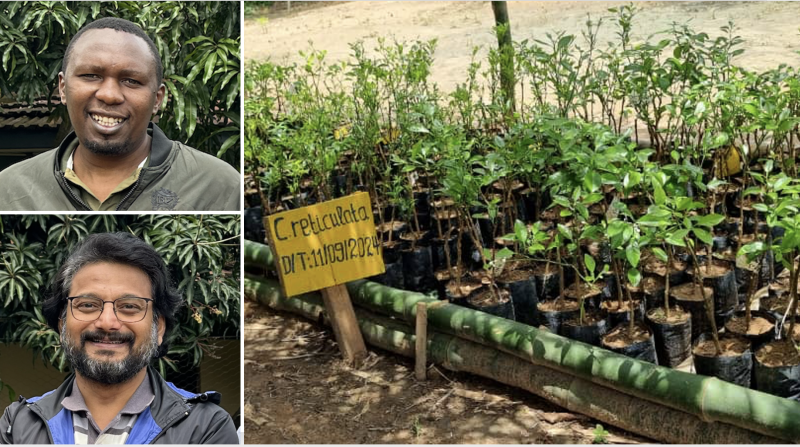
Samuel Muthemba, Prasad Hendre, and a flourishing nursery of Citrus sinensis, an orange variety. Photos Cathy Watson and Samuel Muthemba / CIFOR-ICRAF
This is highly specialised technical work inside a project that recognizes the interconnectedness of challenges and is engaging stakeholders to explore these complexities and better understand communities. Important planks of work include establishing social and behavioral communication strategies; gathering data on production, consumption of food, water, sanitation, gender, and forest activities; and visualizing connections between food systems, nutrition, gender dynamics and environmental factors.
Happening right now are surveys in which researchers are assembling seasonal food calendars; ascertaining wild food use and socio-cultural dimensions of food; assessing diets through a 24-hour recall; examining perceptions of deforestation; and measuring the BMI and mid-upper arm circumference of children and caregivers for indicators such as stunting and wasting.
With just two years remaining, the project clock is ticking. But for Stepha McMullin, the pioneer of Food Tree Portfolios designed to provide year-round micronutrients and plug seasonal gaps, and Amy Ickowitz, who quantifies the direct contribution of forests to diets, the successful airlift marks a significant milestone and is something to celebrate.
“It lays a strong foundation for ensuring a solid fruit tree seed system that will support communities to produce and consume more diverse and better quality fruits, which are critical for healthy diets and well-nourished children,” say the CIFOR-ICRAF researchers leading Nutriscapes Yangambi.
We want you to share Forests News content, which is licensed under Creative Commons Attribution-NonCommercial-ShareAlike 4.0 International (CC BY-NC-SA 4.0). This means you are free to redistribute our material for non-commercial purposes. All we ask is that you give Forests News appropriate credit and link to the original Forests News content, indicate if changes were made, and distribute your contributions under the same Creative Commons license. You must notify Forests News if you repost, reprint or reuse our materials by contacting forestsnews@cifor-icraf.org.